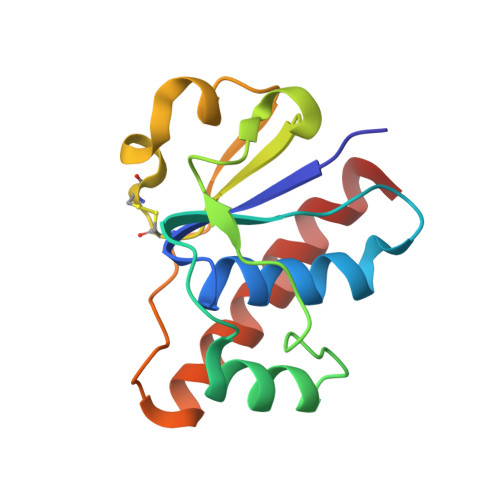A Hybrid Mechanism for the Synechocystis Arsenate Reductase Revealed by Structural Snapshots during Arsenate Reduction.
Hu, C., Yu, C., Liu, Y., Hou, X., Liu, X., Hu, Y., Jin, C.(2015) J Biol Chem 290: 22262-22273
- PubMed: 26224634
- DOI: https://doi.org/10.1074/jbc.M115.659896
- Primary Citation of Related Structures:
2MYN, 2MYP, 2MYT, 2MYU - PubMed Abstract:
Evolution of enzymes plays a crucial role in obtaining new biological functions for all life forms. Arsenate reductases (ArsC) are several families of arsenic detoxification enzymes that reduce arsenate to arsenite, which can subsequently be extruded from cells by specific transporters. Among these, the Synechocystis ArsC (SynArsC) is structurally homologous to the well characterized thioredoxin (Trx)-coupled ArsC family but requires the glutaredoxin (Grx) system for its reactivation, therefore classified as a unique Trx/Grx-hybrid family. The detailed catalytic mechanism of SynArsC is unclear and how the "hybrid" mechanism evolved remains enigmatic. Herein, we report the molecular mechanism of SynArsC by biochemical and structural studies. Our work demonstrates that arsenate reduction is carried out via an intramolecular thiol-disulfide cascade similar to the Trx-coupled family, whereas the enzyme reactivation step is diverted to the coupling of the glutathione-Grx pathway due to the local structural difference. The current results support the hypothesis that SynArsC is likely a molecular fossil representing an intermediate stage during the evolution of the Trx-coupled ArsC family from the low molecular weight protein phosphotyrosine phosphatase (LMW-PTPase) family.
Organizational Affiliation:
From the College of Chemistry and Molecular Engineering, Beijing Nuclear Magnetic Resonance Center.














